MyPortugalHoliday.com
The best independent guide to Central Portugal
MyPortugalHoliday.com
The best independent guide to Central Portugal
Day trip to Evora from Lisbon for 2026
A day trip to Evora is like stepping back into the glorious days of medieval Portugal.
The cobbled streets and gothic architecture of the city's historic quarter have barely been altered since the 15th century, when Evora was the home of the Portuguese nobility - and the second most important city in Portugal, after Lisbon.
Today, for a day trip, you'll discover a city that boasts a seamless blend of its proud history and authentic Portuguese character. Contained within Evora is an imposing cathedral, a beautifully-preserved Roman temple and a ghoulish bone chapel, along with traditional restaurants and an infectious, unhurried pace of life.
It makes an ideal destination for a day trip, being a relatively compact city that offers a variety of fascinating sights and attractions. The only downside to taking a day trip from Lisbon is the considerable amount of travel involved (100 minutes by train or 85 minutes driving), and you may decide that an overnight stay is better.
This article will detail a day trip and 1-day tour of Evora, helping you get the most from your trip here.
Related articles: Introduction to Evora
What are the major sights of Evora?
You’ll find a host of sights and attractions in Evora, the best of which are:

The Gothic Se Cathedral, with its delightfully mismatched towers, imposing granite stone interior and panoramic views from its rooftop.
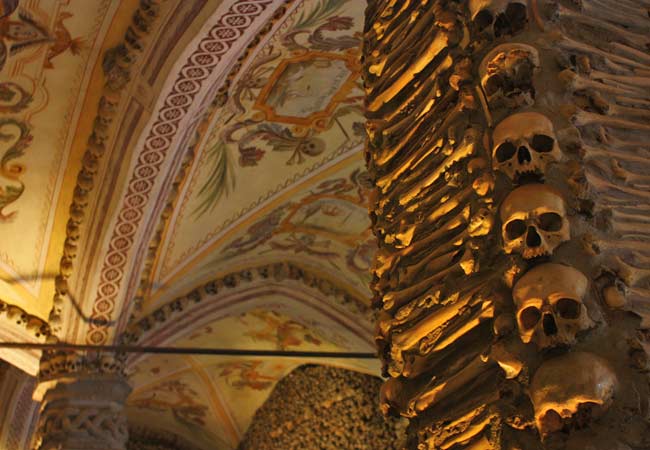
The Capela dos Ossos, a macabre chapel that is the final resting place for over 5,000 skeletons that were exhumed from the city's graves. As well as storing these, the bones and skulls were also used to decorate the creepy chapel.
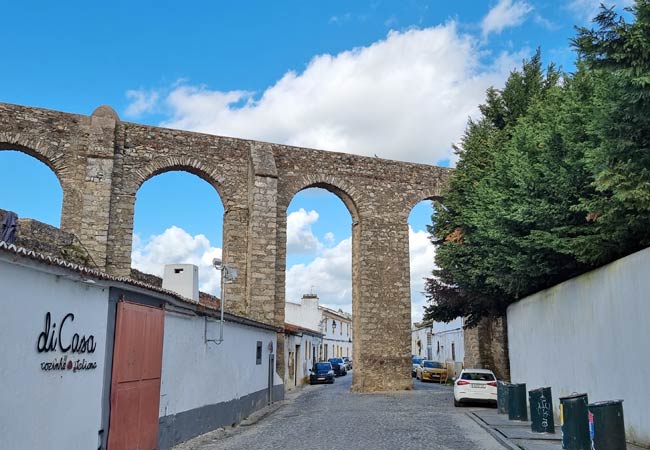
The Aqueduto da Água de Prata is a marvel of 16th-century engineering, which transports water for over 18km into the city via a series of massive aqueducts. Within the city, houses and shops have been constructed beneath the mighty stone arches.

The Praça do Giraldo is the bustling central plaza of Evora, which has witnessed the history of the city played out over its 700 years.
Why have a day trip to Evora?
Evora is a fantastic location for a day trip from Lisbon. The city contains many interesting sights and is much less touristy than the other popular day trip from Lisbon - such as Sintra, Obidos and Cascais.
Part of Evora's appeal is its authentic Portuguese atmosphere and the unhurried pace of life of the Alentejo region. This makes the city ideal to visit if you embrace the slower pace of travel or tire of the endless amounts of tourists in the Lisbon region.
Insight: We recommended this order for day trips from Lisbon: 1) Sintra 2) Cascais 3) Setubal 4) Evora 5) Mafra and Ericeira 6) Obidos
Practicalities for a day trip to Evora from Lisbon
The biggest consideration for a day trip to Evora from Lisbon will be the amount of travel involved. The city can be seen within 4 to 5 hours of sightseeing, but this makes for a very long day when the 3 to 4 hours of travel time are added it.
There are direct train and bus services connecting Lisbon to Evora (details later on), and we always recommend taking the train, which is more comfortable and relaxing. The only downside is that the number of train departures is very limited.
During the peak season (Jun to Aug), Evora can get extremely hot (+40C/104F), baking under the intense summer sun and lacking the refreshing breezes of the coastline. For any day trip, we would suggest starting as early in the day as possible to avoid the mid-day sun.
Evora will be a significantly less expensive day trip than Sintra, Obidos or Cascais. The entrance fees to all of the tourist attractions are much cheaper or free (such as the Roman temple), while the price of meals will be more reflective of normal prices in Portugal. It is advisable to bring some cash to Evora, as a surprisingly high number of places are unable to take card payments.
Accessibility: The historic centre of Evora has cobbled streets and some steep slopes, which may make it difficult to explore for less mobile visitors.
A suggested 1-day tour of Evora
The best way to explore Evora is to simply enter the city walls and enjoy a stroll. The city contains so many small but interesting sights, which are best discovered by just wandering route free. These sights could include a section of the ancient Roman walls, a small alley with an authentic restaurant or one of the many arches of the aqueduct.
If you are a visitor who prefers a definite route, the following map provides a suggested 1-day tour of Evora. The green line marks the classic tour of the historic centre, which includes the cathedral, the Roman temple, the university and the bone chapel.
The yellow line is an additional tour to the north of the city, which includes the Rua do Cano (street with the aqueduct) and the city walls. The two grey lines are the routes to and from the train and bus stations.
Legend: 1) Praça do Giraldo 2) Igreja de Santo Antão 3) Rua João de Deus 4) Igreja do Salvador do Mundo 5) Câmara Municipal 6) Arco Romano 7) Rua Cinco de Outubro 8) Roman temple 9) Jardim Diana 10) Igreja de São João Evangelista 11) Museu de Evora 12) Catedral de Évora 13) Universidade de Évora 14) Portas de Moura 15) Fonte das Portas de Moura 16) Igreja da Graça 17) Igreja de São Francisco 18) Capela dos Ossos 19) Mercado Municipal 22) Jardim Público de Évora 21) Palácio de Dom Manuel I 22) Rua do Cano 23) Porta Velha da Lagoa 24) Aqueduto da Água de Prata 25) Porta do Raimundo
Insight: This tour is detailed at the end of this article
Have you considered an organised tour to Évora?
An organised tour is a fantastic way to discover Évora, particularly if you are staying in Lisbon. The quality of tours in Portugal is very high, with knowledgeable and enthusiastic guides who design tours for modern tourists. A tour combines many attractions into a single day and avoids the hassle of public transportation.
We have worked with GetYourGuide over the past six years, and some of their best excursions to Évora departing from Lisbon include:
Where to Eat in Evora
Dining in Evora is an essential part of the Alentejo experience, with options ranging from timeless institutions to innovative modern kitchens. For a legendary culinary pilgrimage, seek out the tiny, eight-seat counter at Botequim da Mouraria, or immerse yourself in the multi-course, no-menu feast at Taberna Típica Quarta-feira. For a more formal taste of history, Restaurante Fialho has been a bastion of classic Alentejo dining for generations.
The new guard is brilliantly represented by the refined farm-to-table concept at Origens and the creative Portuguese tapas at Dona Laura, which is perfect for a more social meal. For heartfelt, high-quality family cooking in a cozy setting, Vinho e Noz is a consistently top-rated choice. If you’re seeking an authentic and affordable neighborhood meal beloved by locals, look no further than Taska Fina.
Many of Evora’s most memorable restaurants are small, family-run establishments where demand is high. For more details, see our complete guide on where to eat in Evora.
Travel to Evora
The easiest way to travel to Evora from Lisbon is by car. The route is via the A6 expressway, but unfortunately this is a toll road.
The best route into Evora is taking junction 5 from the A6 and following the N114 into central Evora. There is a large free car park (GPS: 38.566175, -7.907219) close to the end of the N114, and this is the recommended location to park your car.
Public transport is almost as fast as driving, and makes the start and end of the day more relaxing. The express train to Evora takes 1h33 and departs from the Oriente train station in Lisbon. The return fare is €22.50 (€12.50 single). The downside is the limited number of departures, but the weekday departure at 09:02 (or 09:58 at weekends) and return from Evora at 16:57 are ideal for a day trip.
To purchase tickets and check the latest timetable, please see the Comboios de Portugal website: https://www.cp.pt/
The express bus service offers many more daily departures from Lisbon to Evora, and the tickets are much cheaper if purchased in advance. Personally, we find train travel more relaxing and comfortable.
The intercity bus services are from Rede Expressos, which depart from the Sete Rios bus station in Lisbon, or the low-cost bus operator FlixBus, which depart from the Oriente bus station. Further details can be found on their websites:
• Rede Expressos- https://rede-expressos.pt/
• FlixBus - FlixBus
Both the bus and train stations are to the west of the historic centre of Evora and are just a short walk.
Insight: The tourist office of Evora is located on the Praça do Giraldo, so do pop in here to get a free map.

Evora train station is modern but very quiet
1-day tour of Evora
The tour begins in Praça do Giraldo, the central plaza and heart of Evora. This lively plaza is surrounded by mediaeval buildings, including the Banco de Portugal, the tourist office building and the Igreja de Santo Antão. The Santo Antão church may have an unassuming exterior, but it boasts an ornate interior and is one of the hidden gems of Evora.
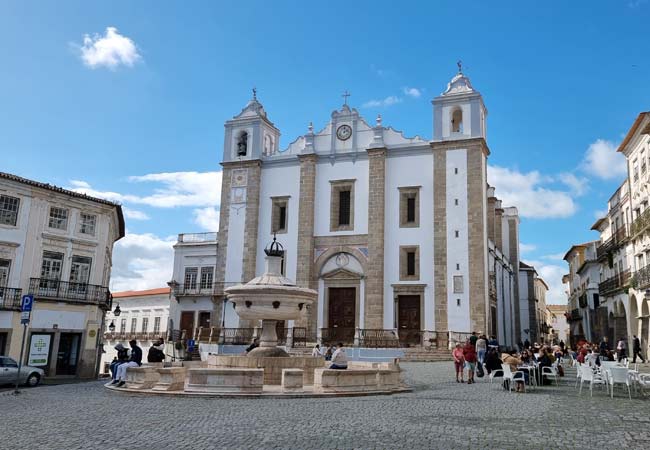
Igreja de Santo Antão
Standing at the centre of the Praça do Giraldo is the Fonte da Praça do Giraldo, where historically, water from the aqueduct flowed out from. The eight outlets in the fountain were for each of the eight streets that led from the plaza.
Exit the Praça do Giraldo along the Rua João de Deus, which is a popular shopping street. This street ends at the Largo Luiz de Camões, and here you can see the low arches of the aqueduct.
Next, head east to the Praça do Sertório, where the Câmara Municipal (Town Hall) and Igreja do Salvador do Mundo stand. Just off the plaza is the Arco Romano de Dona Isabel, one of the old gateways into the city.
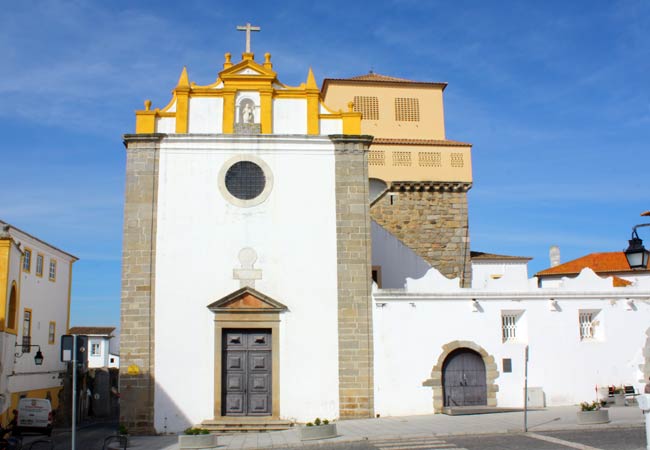
Igreja do Salvador do Mundo
Afterwards, head back to the Praça do Giraldo passing the Igreja de São Tiago.
From the Praça do Giraldo, stroll up Rua Cinco de Outubro, a charming street lined with numerous craft and gift shops specialising in cork products. Along this street, you'll find the Rota dos Vinhos do Alentejo, where you can taste a variety of wines from the Alentejo region.
At the top of the hill lies the cathedral, but before entering, cross the cobbled street to see Evora's most famous sight: the Roman temple. This majestic temple was dedicated to Emperor Augustus and has 14 of its original 18 Corinthian columns still standing.
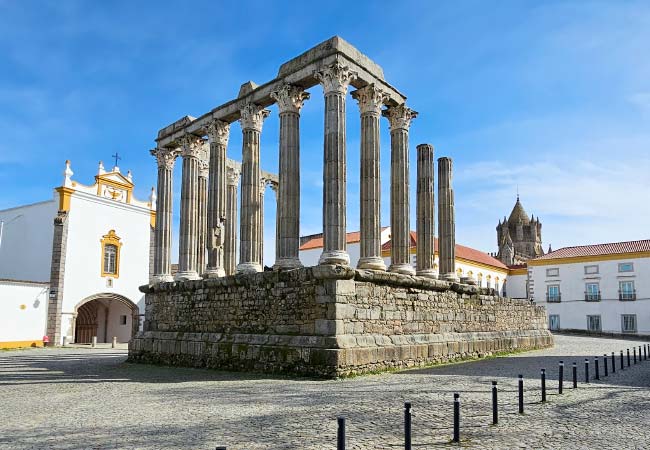
Next to the temple is the pretty Jardim Diana, and from the rear of the garden is a wonderful viewpoint over the northern side of Evora. Here you’ll find a traditional kiosk serving drinks and snacks on the Jardim Diana, which is a great spot if you're in need of refreshment.
Behind the Roman temple is the Igreja de São João Evangelista, which contains some of the finest Azulejos tile paintings in Portugal. Sadly, the entrance fee is €6.
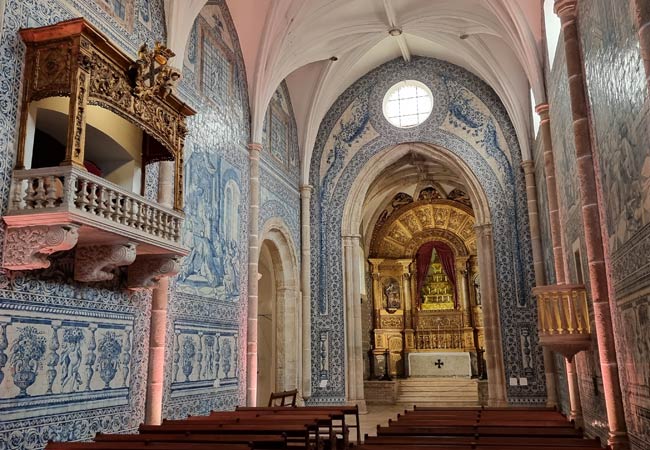
Igreja de São João Evangelista
If you are interested in history, you may wish to visit the Museu Nacional Frei Manuel do Cenáculo, which exhibits a diverse collection of items from the Roman era up until the 18th century.
The next sight to visit is the Se Cathedral and adjoining cloister (€6). There is a lot to see here, but the highlight for most visitors is the view from the top of the roof of the cathedral, which is accessed via a narrow, circular staircase.
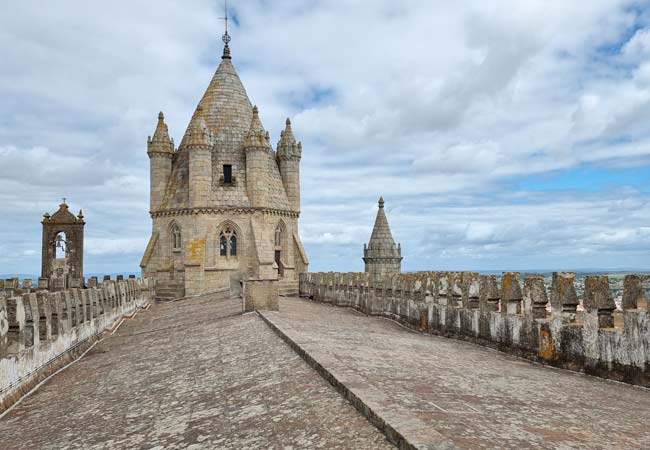
There is a magnificent view from the top of the roof of the cathedral
The University of Evora is the next stop on the route. This is the second oldest university in Portugal, with the main teaching building dating from the 16th century.
After the university, walk along the Rua do Conde da Serra da Tourega, which ends at the Largo da Porta Moura. On this plaza, you can see two towers from the Roman walls and a beautiful view of the cathedral. To the south is the Fonte das Portas de Moura, the second fountain of Evora fed by the aqueduct.
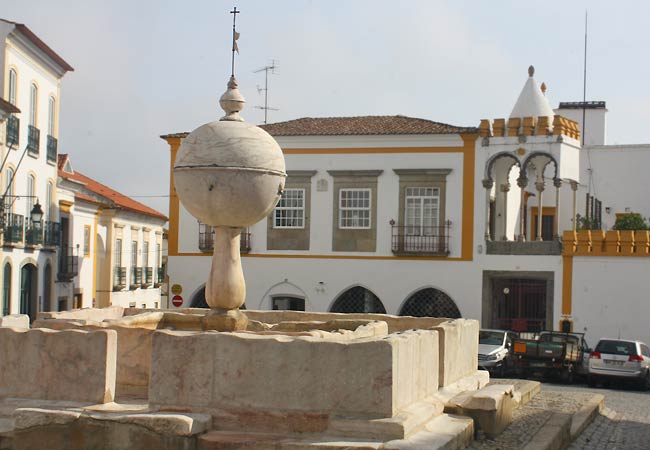
Fonte das Portas de Moura
The Igreja da Graça is an impressive Renaissance church adorned with four statues of the god Atlas (who supports the world on his back). There is no point entering the church, as the interior is very bland.
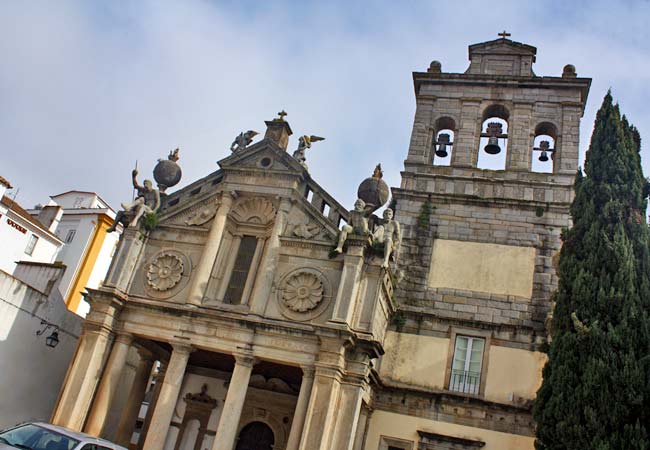
Igreja da Graça
The next church to visit is the Igreja de São Francisco. This is always a highlight of a trip to Evora, as in the attached monastery you will find the Chapel of Bones (Capela dos Ossos).
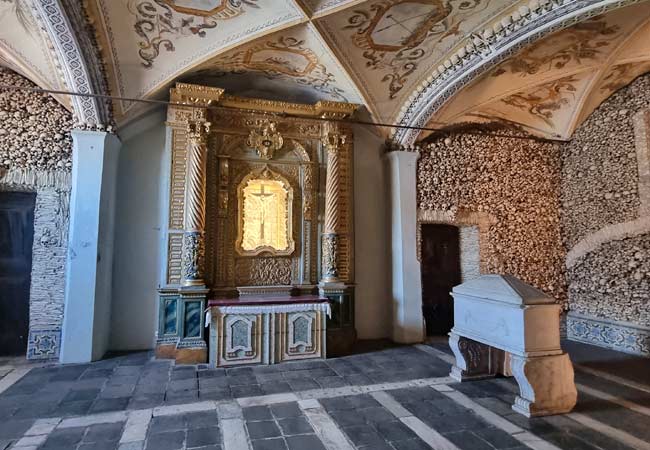
This ghoulish chapel (€6) contains the bones of over 5,000 bodies that were exhumed from the city's graves. The bones are stacked in the recesses of the walls, but also are used to decorate the chapel. Along with the bones, death-focused frescos are painted on the ceilings and the mummified bodies of a woman and child are prominently displayed.
To counter all of the death, the attached museum displays a charming collection of nativity scenes.
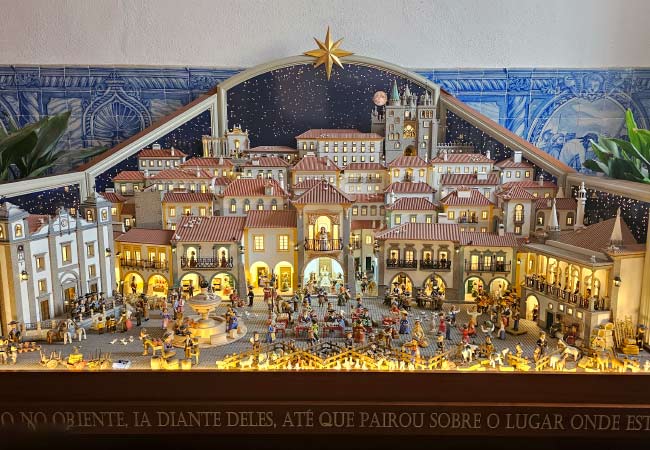
After the Capela dos Ossos, take some time to visit the interior of the mighty Igreja de São Francisco, the most important church of Evora and used by mediaeval Portuguese kings.
Opposite the church is the Mercado Municipal, a traditional market with many fresh produce stalls.
Close by is the Jardim Público de Évora, which was once the grounds of the Palácio de Dom Manuel I.
This previously magnificent palace was almost destroyed after Evora lost its political and trading importance in the early 17th century. The only remaining section is the Women's Wing. The shaded Jardim Público is a lovely setting for a picnic or to escape the intense summer sun.
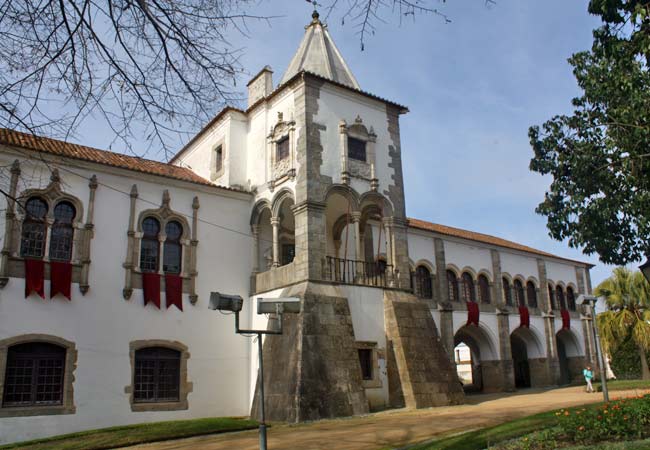
Palácio de Dom Manuel I
From the park, exit via the Rus da República and take a stroll around the outside of the city walls. These outer walls were constructed in the 15th century to protect Evora as it expanded outside of the original Roman walls.
You can then head back into the historic centre via the Porta do Raimundo gateway, which leads uphill to the Praça do Giraldo. Between the Rua do Raimundo and the Rua dos Mercadores is the former Jewish quarter of Evora, which is a warren of narrow streets.
For the final part of the day, visit the Rua do Cano. This delightful street has houses and shops constructed below the arches of the aqueduct. These arches start small, barely large enough to walk under, but at the end of the road they tower above the houses.
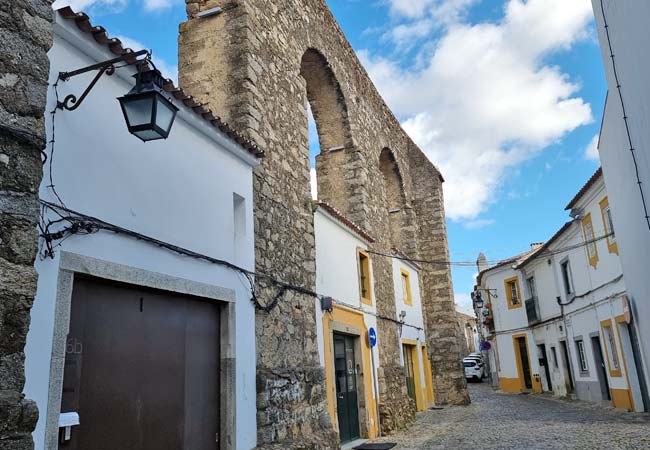
Rua do Cano
Just outside of the city walls, the arches reach over 30-metres as they cross the IP2 road.
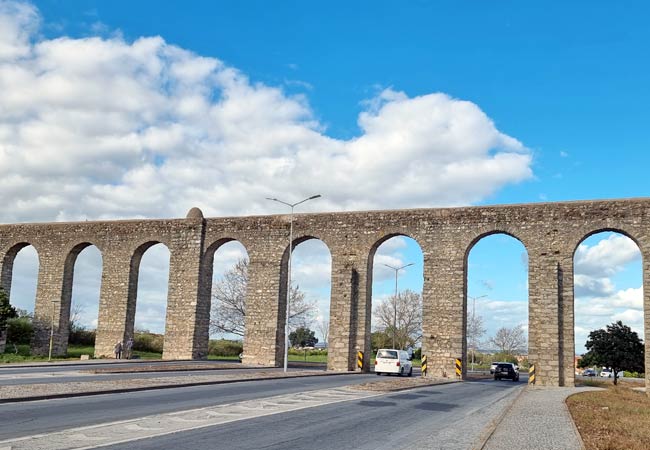
From here, walk around the exterior of the city walls to the bus or train station. There is a pretty garden and pathway that extends around the walls, making this a pleasant way to finish the day.
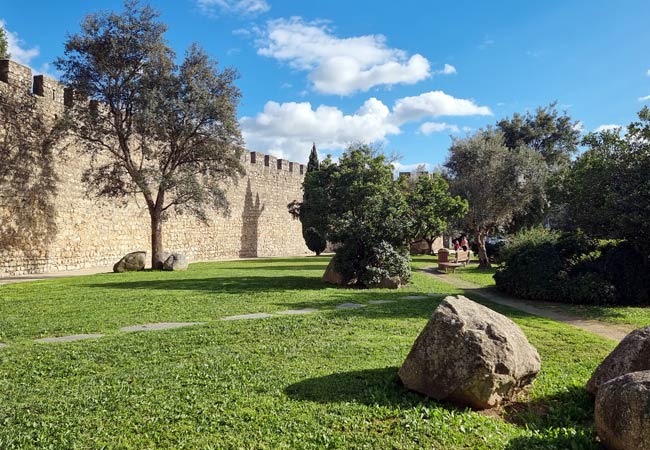
Evora or Obidos for a Day Trip?
Evora and Obidos are both delightful and historic cities that are popular day trips from Lisbon. Obidos is so popular it can feel over run with coach loads of day trippers, especially on summer weekends and it is advised to visit in the working week (Mon-Fri), where possible.
Evora is much larger than Obidos and there are many more tourist sites, although it is also much further away than Obidos. This long journey can rule out Evora as a day trip for tourists who prefer shorter excursions. For visitors who have time, they can spend a night in Evora, while Obidos can easily be seen within a few hours.
However, for those who can tolerate a longer journey, and high temperatures (see next section), it is highly recommended to visit Evora on a day trip to make the most of time spent in Portugal. The recommended day trips from Lisbon are; Sintra, Cascais, Evora or Obidos and Mafra.


























